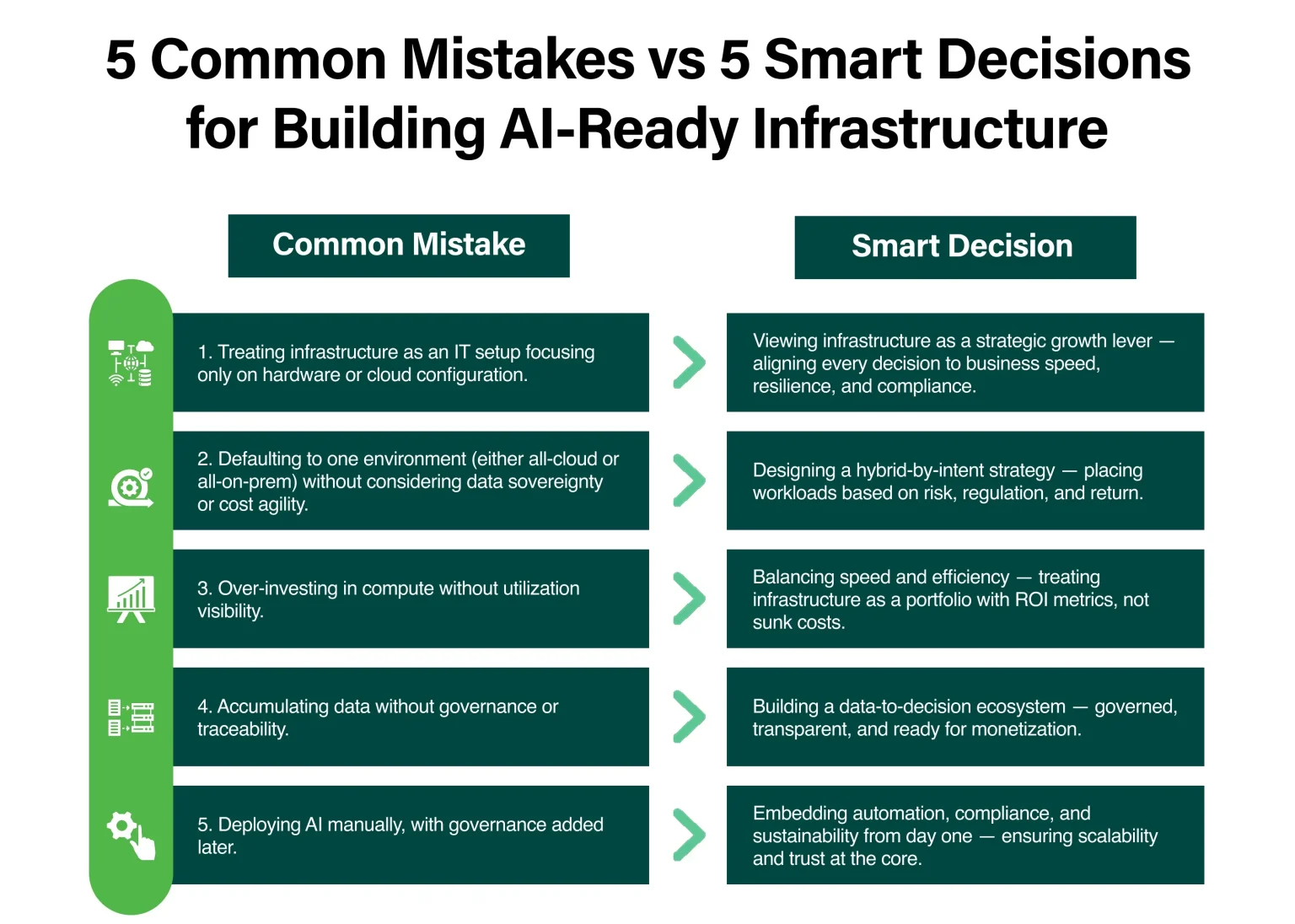From Experimentation to Enterprise Strategy
Artificial Intelligence has officially graduated from lab experiments to boardroom strategy. Today, it underpins everything from fraud detection and predictive healthcare to logistics optimization and hyper-personalized customer journeys.
Yet as organizations rush to deploy AI at scale, most are discovering that success isn’t limited by model accuracy — it’s defined by the infrastructure choices made long before the first model is trained.
The right infrastructure decisions determine how fast innovation happens, how safely data moves, how efficiently capital is used, and how resilient the business becomes. These are not IT configuration calls. They’re strategic bets with financial, regulatory, and reputational consequences.
Here are five boardroom-level infrastructure decisions every enterprise leader must get right to turn AI ambition into real-world advantage.
1. Location Strategy: Where Will AI Live?
This is no longer a question of servers – it’s a question of control, sovereignty, and the cost of innovation.
Choosing between on-premises, cloud, or hybrid infrastructure shapes how fast you can experiment, how much you spend, and how compliant you remain.
The Trade-off:
- Cloud offers agility and scale but can lead to runaway costs or data-sovereignty challenges.
- On-prem ensures control and compliance but can limit elasticity.
- Hybrid blends both – if governed intelligently.
The Business Lens:
Every percentage point of latency or extra storage fee scales exponentially across AI workloads. The wrong call can lock the enterprise into vendor ecosystems that are hard – and costly – to exit.
The Smart Decision:
Design a flexible location strategy anchored in workload sensitivity. Keep high-risk or regulated data on-prem; move elastic training and inference to scalable, cost-optimized cloud environments. The goal: control without constraint.
2. Investment Focus: Speed vs Efficiency
The question isn’t “how many GPUs do we buy?” – it’s “how do we balance speed to innovation with financial discipline?”
Enterprises that equate AI progress with unchecked spending often find themselves with idle infrastructure and ballooning budgets. Others that underinvest end up bottlenecked by capacity constraints.
The Trade-off:
- Scale up aggressively to accelerate innovation.
- Or scale out cautiously to balance performance with ROI.
The Business Lens:
This decision defines AI’s cost-to-value ratio. Poorly aligned investments erode margins and stakeholder confidence. Leaders must align capital allocation with expected business impact – not with hype cycles.
The Smart Decision:
Treat AI infrastructure like a portfolio investment – with risk diversification across high-performance environments and cost-efficient capacity. The winners are those who measure return on compute the same way they measure return on capital.
3. Data as Fuel: Build for Quality, Not Just Quantity
AI thrives on data – but more data doesn’t automatically mean better intelligence. The real differentiator is data readiness: how well it’s governed, shared, secured, and monetized.
The Trade-off:
- Rapid data accumulation vs curated, high-quality, governed datasets.
- Short-term agility vs long-term trust and traceability.
The Business Lens:
Poor data governance leads to compliance exposure and erodes confidence in AI outcomes. Models trained on incomplete or biased data can cost millions in wrong decisions and reputational harm.
The Smart Decision:
Establish a data-to-decision framework – one that emphasizes lineage, transparency, and accessibility. Govern data as a business asset with its own P&L impact. In AI, trust in data equals trust in outcomes.
4. Agility at Scale: Automate or Fall Behind
AI success doesn’t end at deployment – it begins there.
Enterprises that can replicate, update, and govern AI models across markets gain a structural advantage. Those relying on manual processes soon drown in complexity.
The Trade-off:
- Manual orchestration offers control but limits speed.
- Automation accelerates scale but demands upfront alignment and cultural shift.
The Business Lens:
Every delay in retraining a model or re-deploying across geographies is lost market opportunity. Automation determines how fast ideas become impact.
The Smart Decision:
Build a culture of operational agility. Invest in repeatable, automated processes that enable rapid iteration – not reinvention. The organizations that industrialize AI operations today will outpace competitors tomorrow.
5. Trust & Responsibility: Compliance, Security & ESG
In the AI era, trust is infrastructure.
The most sophisticated systems lose their license to operate if they compromise privacy, fairness, or environmental responsibility.
The Trade-off:
- Build fast and fix governance later.
- Or embed compliance, security, and sustainability into the design.
The Business Lens:
Regulatory non-compliance can cost up to 4% of global revenue. ESG failures can erode years of brand equity. Sustainability targets increasingly influence investor confidence.
The Smart Decision:
Bake responsible AI principles into infrastructure design – from encryption and data residency to renewable energy use and model efficiency. Compliance, security, and sustainability are not overheads; they are strategic differentiators.
From Failure Traps to Smart Decisions: What Leaders Do Differently
Even with the best intentions, many AI initiatives fall into predictable traps.
Here’s how today’s AI leaders are reframing those pitfalls into strategic, boardroom-level choices – turning infrastructure from a cost center into a growth enabler.

Conclusion: Infrastructure as a Strategic Lever
AI is now a boardroom agenda, not an R&D experiment. The smartest algorithms in the world can’t compensate for poor infrastructure decisions.
When leaders treat infrastructure as a strategic lever – balancing agility with control, speed with efficiency, and innovation with trust – they create organizations that can scale AI responsibly and profitably.
The right infrastructure doesn’t just support AI. It amplifies business potential, turning pilots into production, and ambition into enterprise-wide impact.

Manzar Saiyed, Vice President - Service Delivery, CtrlS Datacenters
With over 15 years of rich experience in project and program management, Manzar has been instrumental in planning and executing mid to large size complex initiatives across different technologies and geographies. At CtrlS, he is responsible for solutioning and bidding for large system integration projects across emerging markets.


